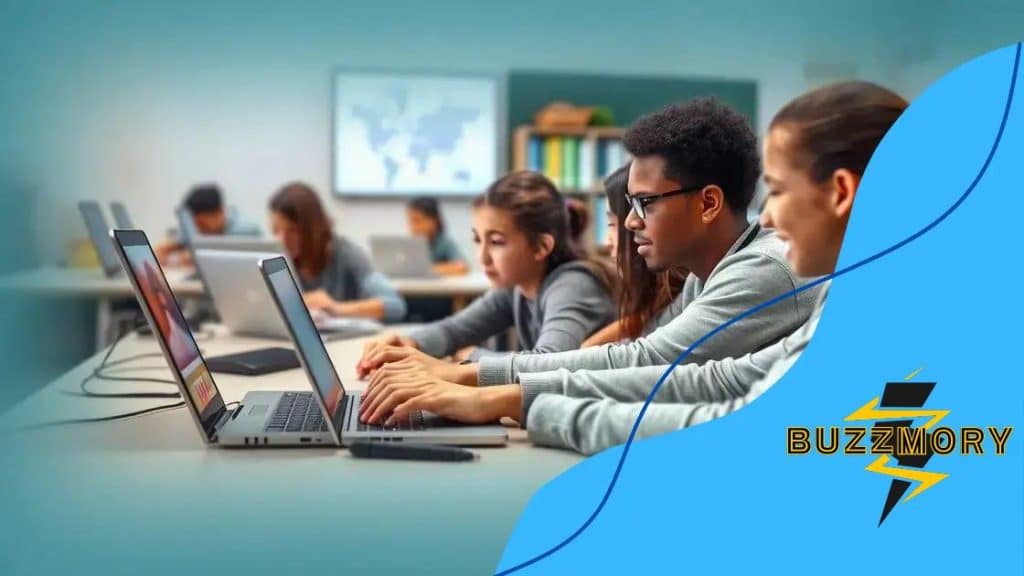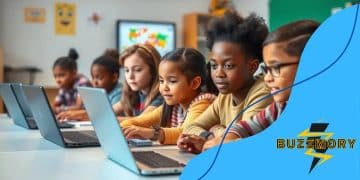The impact of virtual classrooms on student collaboration

The impact of virtual classrooms on student collaboration is significant, enhancing engagement through technology while presenting challenges like technical issues and limited personal interaction.
The impact of virtual classrooms on student collaboration is significant, changing how students interact and learn together. Have you noticed how teamwork evolves in a digital space? Let’s dive into these dynamics.
Understanding virtual classrooms
Understanding virtual classrooms is essential in the modern education landscape. These platforms are not just about watching lectures; they create an interactive space for learners. They connect students from all over, allowing them to share ideas and collaborate.
What are virtual classrooms?
A virtual classroom is an online learning environment where instructors and learners interact. It offers tools like video conferencing, chat, and shared documents. This can replace traditional classrooms, making education accessible from anywhere.
Key features of virtual classrooms
- Real-time communication through video and audio.
- Interactive tools like polls and quizzes.
- Access to resources and study materials at any time.
- Ability to record sessions for later review.
With these features, students can engage actively. They can ask questions, participate in discussions, and work on group projects, just like in a physical classroom. This interaction is crucial for developing collaboration skills.
Benefits of using virtual classrooms
One of the main advantages of virtual classrooms is flexibility. Students can learn at their own pace and schedule. This is especially helpful for those balancing work and study. Moreover, it offers a chance to learn from diverse perspectives.
In a virtual setting, students from different backgrounds can share their insights. This diversity enriches the learning experience. Virtual classrooms also often provide access to more resources than traditional settings. Students can explore materials beyond their local curriculum and engage with experts around the globe.
However, navigating these new environments can be challenging. Some students may feel isolated without face-to-face interaction. It’s important for educators to foster a sense of community within these platforms.
The role of technology in collaboration
The role of technology in collaboration is vital, especially in today’s learning environments. It provides students with tools to work together effectively, no matter where they are.
How technology enhances collaboration
Technology offers various features that promote teamwork. For instance, platforms like Zoom and Microsoft Teams allow students to meet and discuss projects in real time. This accessibility enables seamless communication.
Key tools for collaboration
- Video conferencing software for live discussions.
- Document sharing platforms for group projects.
- Task management apps for keeping everyone on track.
- Instant messaging tools that facilitate quick communication.
These tools not only enhance coordination but also help students develop essential skills. Working together in a virtual environment teaches responsibility and accountability.
Moreover, integrating technology into the classroom can make learning more engaging. Interactive tools, such as online whiteboards and quizzes, keep students focused and motivated. When students feel involved, their collaboration improves significantly.
However, it’s important to address potential challenges. While technology connects students, it can also lead to distractions. Educators must create a balance to ensure that students stay on task while utilizing these digital tools.
Benefits of virtual learning environments

The benefits of virtual learning environments are numerous and significant. These platforms have transformed education, making it more accessible and engaging for students.
Flexible learning opportunities
One of the greatest advantages is flexibility. Students can access materials and lectures at their convenience. This allows them to learn at their own pace, fitting their education around their personal and professional responsibilities.
Enhanced collaboration
Another benefit is enhanced collaboration among students. In a virtual classroom, learners can easily connect and work together on projects using various tools, such as video conferencing and document sharing. This fosters teamwork skills which are crucial in today’s job market.
- Working from anywhere, promoting comfort and ease.
- Connecting with peers from diverse backgrounds.
- Utilizing creative tools for presentations.
- Engaging in discussions that broaden perspectives.
Access to a wealth of resources is another important benefit. Virtual learning environments often provide a range of multimedia content, such as videos, articles, and interactive quizzes. Students can explore topics in depth, making learning richer and more enjoyable.
Moreover, these environments are often equipped with various technologies that enhance the learning experience. For instance, gamification can make learning more fun and engaging, encouraging students to participate actively.
At the same time, virtual learning environments help develop self-discipline and time management skills. As students navigate their education independently, they learn how to prioritize tasks and manage their schedules effectively.
Challenges faced in virtual classrooms
Challenges faced in virtual classrooms are important to understand. As online learning becomes more common, recognizing these obstacles can help educators and students navigate effectively.
Technical issues
One major challenge is technical issues. Students may experience problems like poor internet connections or difficulty using the software. These problems can disrupt learning and make it hard for students to participate fully. Repeated interruptions can lead to frustration, reducing motivation to engage.
Limited personal interaction
Virtual classrooms can also limit personal interaction. Without face-to-face communication, students may feel isolated. Missing the social aspects of learning can impact their emotional well-being and decrease their motivation. It’s crucial for educators to create opportunities for students to connect.
- Encourage group projects to foster collaboration.
- Use breakout rooms for smaller discussions.
- Incorporate social time through casual chats.
- Provide support and check-ins to reinforce community.
Another concern is maintaining engagement in a digital environment. Some students may struggle to focus for long periods. Traditional classroom elements, such as hands-on activities and movement, are harder to replicate online. Keeping lessons dynamic and varied can help combat boredom.
Finally, assessment in virtual classrooms presents its own set of challenges. Ensuring fairness and accuracy in grading can be more complex when students are learning from home. Educators must find effective ways to evaluate learning while maintaining academic integrity.
Future trends in online education
Future trends in online education are shaping the way we learn and teach. As technology evolves, so do the methods and tools used in education.
Increased use of artificial intelligence
One significant trend is the increased use of artificial intelligence (AI) in learning environments. AI can provide personalized learning experiences, adapting content to meet individual needs. For example, AI systems can analyze students’ performance and suggest resources tailored to their learning styles.
More interactive and immersive experiences
Another exciting development is the growing popularity of virtual reality (VR) and augmented reality (AR) in education. These technologies create immersive learning experiences that can engage students more deeply. For instance, students can explore historical sites or conduct science experiments in virtual labs from their own homes.
- Virtual classrooms with VR setups for real-life simulations.
- AR applications that overlay information on real-world objects.
- Gamified learning experiences that boost motivation.
- Collaboration tools that enhance group interaction.
Additionally, the shift towards hybrid learning models is likely to continue. These models combine in-person and online instruction, offering flexibility for both students and educators. This approach can cater to different learning preferences and needs, making education more inclusive.
Furthermore, as online education becomes more mainstream, there will be a focus on improving accessibility. Educators and institutions are working to ensure that all students have equal access to high-quality resources, regardless of their background or location. This might involve providing more devices and internet access in underserved communities.
\n
FAQ – Frequently Asked Questions about Virtual Classrooms
What are virtual classrooms?
Virtual classrooms are online learning environments where students and instructors interact using technology for lectures and discussions.
How do virtual classrooms enhance collaboration?
They provide tools like video conferencing and document sharing, allowing students to work together on projects from different locations.
What challenges do students face in virtual classrooms?
Common challenges include technical issues, limited personal interaction, and difficulties in maintaining focus during online sessions.
What are the future trends in online education?
Future trends include increased use of artificial intelligence, immersive learning with VR, hybrid models combining online and in-person classes, and a focus on accessibility.





